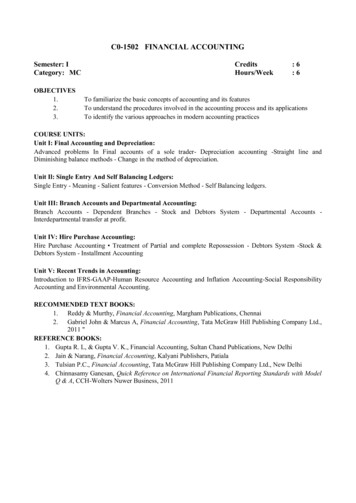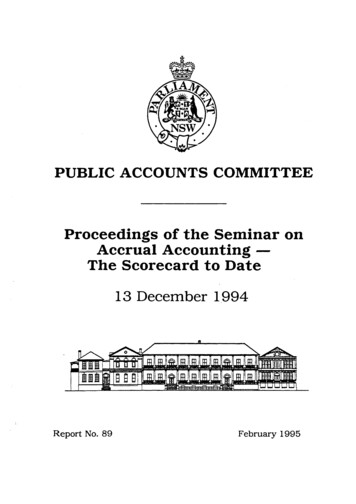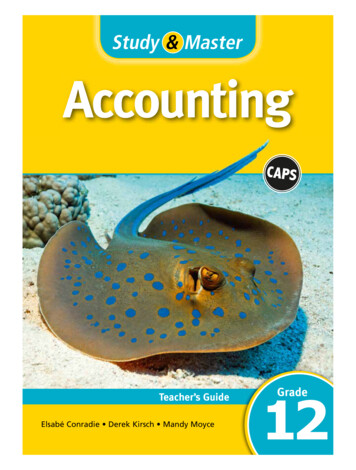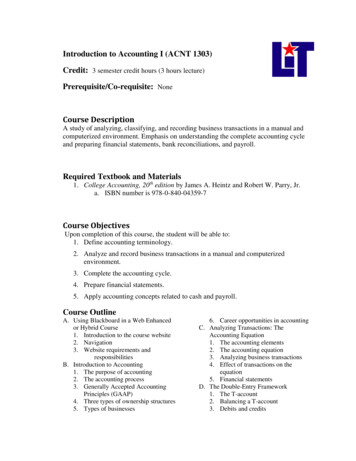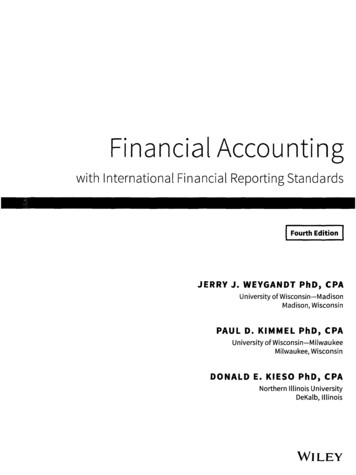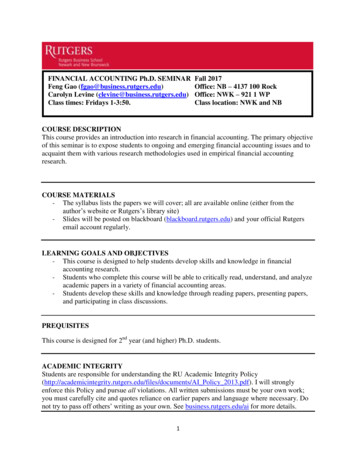
Transcription
FINANCIAL ACCOUNTING Ph.D. SEMINARFeng Gao (fgao@business.rutgers.edu)Carolyn Levine (clevine@business.rutgers.edu)Class times: Fridays 1-3:50.Fall 2017Office: NB – 4137 100 RockOffice: NWK – 921 1 WPClass location: NWK and NBCOURSE DESCRIPTIONThis course provides an introduction into research in financial accounting. The primary objectiveof this seminar is to expose students to ongoing and emerging financial accounting issues and toacquaint them with various research methodologies used in empirical financial accountingresearch.COURSE MATERIALS- The syllabus lists the papers we will cover; all are available online (either from theauthor’s website or Rutgers’s library site)- Slides will be posted on blackboard (blackboard.rutgers.edu) and your official Rutgersemail account regularly.LEARNING GOALS AND OBJECTIVES- This course is designed to help students develop skills and knowledge in financialaccounting research.- Students who complete this course will be able to critically read, understand, and analyzeacademic papers in a variety of financial accounting areas.- Students develop these skills and knowledge through reading papers, presenting papers,and participating in class discussions.PREQUISITESThis course is designed for 2nd year (and higher) Ph.D. students.ACADEMIC INTEGRITYStudents are responsible for understanding the RU Academic Integrity documents/AI Policy 2013.pdf). I will stronglyenforce this Policy and pursue all violations. All written submissions must be your own work;you must carefully cite and quotes reliance on earlier papers and language where necessary. Donot try to pass off others’ writing as your own. See business.rutgers.edu/ai for more details.1
ATTENDANCE AND PREPARATION POLICYPlease read or at least skim all of the papers prior to class, and take notes in the margins. Thisway, you will be able to ask questions and follow the lecture.For the student presentation papers, you must read each carefully, and prepare three questions (tobe submitted each week) about the paper.CLASSROOM CONDUCTTypically, Carolyn or Feng will present during the first 60-90 minutes of class. There may be atheoretical model and an application for each topic, or two applications. The topics and readingsare listed below in the class schedule. Students are expected to read each of the papers prior toevery class. Papers can be accessed electronically from the library website, SSRN or from theauthors’ personal websites. Feel free to interrupt at any time with questions or comments.Although there are “lectures,” you should treat them as academic seminars.The second half of each weekly class will be student led discussions. One student will beassigned as the “author” of the paper, and will present the paper to the class. This presentationmay use slides, or may be more informal but the role of the author is to describe the (a) researchquestion and the theoretical underpinnings (b) the research methodology and assumptions (c) thedata and (d) the results and interpretation. The other students in the class will be seminarparticipants. Each student will be required to submit three to five questions about the paper priorto class, and should feel comfortable interrupting the “author” during his/her presentation. Part ofyour grade will depend on your participation in these roles.EXAM DATES AND POLICIESThere are no exams. Instead, you will have referee reports and research project milestones,discussed below.REFEREE REPORTSWhen we have outside presenters, you will be expected to thoroughly read their papers andprovide a written referee report.High quality and timely referee reports are essential to the performance of any journal. You willbe asked to referee papers throughout your career, and you will be (implicitly) evaluated (by theeditor) based on the quality of your reports. You might skim the paper first to get an idea of thebig picture, and then read it more carefully to make detailed comments. Make notes in themargins or underline/highlight important issues. Often times, seminar participants will mark uppapers and give the more informal markups directly to the author who is presenting. It isimportant to leave out any nastiness. Authors should be able to learn how to improve their paper2
from your report, whether or not it has a chance for publication in the journal for which you arerefereeing.Begin the report with a (short, one to two paragraph) summary of the research question and thefindings. Then, discuss whether the author has made a contribution, whether there are problemsin the analysis or issues that need clarification or further work. Since this is not an officialrequest from a journal, you need not provide a publication recommendation (i.e.,accept/revise/reject)Typically, referee reports have the following structure Summary and contribution Major Commentso This section is where you raise the major questions and concerns about the paper. Ifthe analysis is incomplete, point it out. If it needs to be more general, makesuggestions and requirements for how the authors could extend or improve the paper.An example of one paragraph (from a sample referee report that I wrote) I also think the paper misses many interesting aspects of disclosure. First, whydoesn’t disclosure allow the firm to be a Stackelberg leader? If that were the case,then there would be some tradeoff which would encourage firms that have positivelycorrelated output to also want to disclose. How do the authors envision thecommitment to a disclosure policy? Why isn’t disclosure determined after observingthe realization? Is it that disclosure is sticky? If that is the case, then there should becosts of disclosure if the correlations are expected to change over time. What, if any,are the penalties to being a “low discloser?”Minor Commentso This section includes small details, questions that can be easily addressed within thecontext of the existing data and framework, typos and other small points. An example(taken from a referee report I wrote about a different paper)o Another missing citation is Hayes (1998).o The main specification (p. 14) is not numbered, but referred to as (2) later in thepaper.o Table 5 does not have raw returns (p.20)RESEARCH PROJECTThe goal is for each student to have a running start on his/her (original) summer research paper.To that end, we will require submission of several milestones along the way. The due dates arelisted in the course schedule and details for each are listed below. Please adhere to the pagelimits.1.Suggestion of a topic (as specific as you can be, but you may select one of the 10-12broad areas we are going to discuss if you do not have a topic in mind). 1 page.a. Do a careful literature search to ensure that your topic has not be fully researched(i.e., the idea must have a component of originality)3
2.3.4.b. List the reasons this area/topic interests you.c. Suggest three or four papers in this area that you would like to read to betteracquaint yourself with the topic.Literature review. 5 pages.a. Using the papers you suggest along with the list that we individualize for you,write a summary of each paper. Discuss the contributions of the paper.b. Propose some ways you could expand on each of these papers (it may be theaddition of a single variable, an alternative approach to measuring the variables ofinterest, or any other changes that would make the paper different and better).c. Discuss how your topic (now, hopefully better fleshed out and more specific) fitsinto this line of research.Research topic proposal. 5 pagesa. What is the research question? Incorporate the feedback you have received onpart (c) of the second milestone.b. How will you address the question? What methodology will you use (be asspecific as possible! A good answer would begin like “I will estimate a modelwhich examines whether trading volume increases with the number ofdiscretionary public disclosures as the independent variable,” NOT “I will runOLS.”c. How will your paper contribute to the existing literature?Research design and Data (no page limit)a. What are the variables you need? Why are these good proxies for the underlyingeconomics?b. What are the control variables you need?c. What will your econometric or analytical approach be?d. Where will you get the data? An answer like “WRDS” is completelyunacceptable. We are looking for specifically how you will measure each variableGRADING POLICYCourse grades are based on your participation, scores on the required submissions (see ResearchProject section and below) and presentations in the class.We may have guest presenters from our faculty (or senior Ph.D. students). On those dates, therewill be no student led discussions, but instead, students will be required to write a referee reportfor the paper that is presented. The faculty member will evaluate the quality of those reports,and inform us which were most helpful for them in revising their papers. The last part of yourgrade will depend on these evaluations.4
COURSE SCHEDULE: The material on the schedule will stay constant, but the order ofclasses may change, due to last minute inclusions of seminars. The location of the class will be inthe location of the seminar (unless there is a conflict for AIS and accounting students; then theclass will be in NWK)Date1234567891011121314TopicItems DueTOPIC 1: DEMAND FOR ACCOUNTING REGULATIONLEVINE LECTURE ONLY [NEWARK]FACULTY PRESENTATION: MOFFITT15-Sep TOPIC 2: EVENT STUDIES:LEVINE LECTURE ONLY [NEWARK]TOPIC 7: ESTIMATING TREATMENT EFFECT USINGEXOGENOUS SHOCK22-SepGAO LECTURE & STUDENT LED DISCUSSION[NEW BRUNSWICK]TOPIC 8: USING INSTRUMENT VARIABLES29-Sep GAO LECTURE & STUDENT LED DISCUSSION[NEW BRUNSWICK]TOPIC 3: VOLUNTARY DISCLOSURE6-Oct LEVINE LECTURE AND STUDENT LED DISCUSSION[NEWARK]TOPIC 9: REGRESSION DISCONTINUITY13-OctGAO LECTURE & STUDENT LED DISCUSSION, [TBD]TOPIC 4: ACCOUNTING METHOD CHOICES20-Oct LEVINE LECTURE & STUDENT LED DISCUSSION[NEWARK]TOPIC 6: THE ROLE OF AUDITORSLEVINE LECTURE AND SENIOR STUDENT27-OctPRESENTATION: CALABRESE[NEWARK]TOPIC 5: INFORMATION ASYMMETRY3-Nov LEVINE LECTURE AND STUDENT LED DISCUSSION[NEWARK]TOPIC 10: MATCHING AND SELECTION10-Nov GAO LECTURE & STUDENT LED DISCUSSION[NEW BRUNSWICK]TOPIC 11: CSR RESEARCH17-NovGAO LECTURE & STUDENT LED DISCUSSION, [TBD]24-Nov THANKSGIVING BREAK – no classSTUDENT MILESTONE PRESENTATIONS1-DecGAO [TBD]STUDENT MILESTONE PRESENTATIONS [NEWARK]8-Dec8-Sep5REFEREEREPORT dueMILESTONE1MILESTONE2REFEREEREPORT dueMILESTONE3MILESTONE4
Topic 1: The demand for accounting regulationAckerlof, G. (1970) THE MARKET FOR "LEMONS": QUALITY UNCERTAINTY AND THEMARKET MECHANISM. The Quarterly Journal of Economics, 84 (3): 488-500.Lev, B. (1988). Toward a theory of equitable and efficient accounting policy. The AccountingReview, Vol LXIII (1). 1-22.Amir, E. (1993). The Market Valuation of Accounting Information: The Case of PostretirementBenefits other than Pensions. The Accounting Review. 68 (4).703-724.Urooj Khan, Bin Li, Shivaram Rajgopal, and Mohan Venkatachalam (2017) Do the FASB'sStandards add Shareholder Value?. The Accounting Review In-Press.Topic 2: Event StudiesMacKinlay, A. C. (1077) Event Studies in Economics and Finance. Journal of EconomicLiterature. XXXV: 13–39.Li Z., Shroff, P., Venkataraman, R. and I. Zhang. (2011). Causes and consequences of goodwillimpairment losses. Review of Accounting Studies 16: 745-778.Haggard K., Howe, J., Lynch, A. (2015) Do baths muddy the waters or clear the air?Journal of Accounting and Economics. 59: 105–117.Topic 3: Voluntary (Accounting) DisclosureRogers, J. and Stocken, P. (2005) Credibility of Management Forecasts. Accounting Review80(4), 1233.Einhorn, E. and A. Ziv (2012). Biased Voluntary Disclosure, Review of Accounting Studies.Ball, R., Jayaraman, S. and Shivakumar, L. (2012) Audited financial reporting and voluntarydisclosure as complements: A test of the Confirmation Hypothesis. Journal of Accounting andEconomics. 53. 136-166.STUDENT PRESENTATION PAPER: Shroff, N., Sun, A., White, H. and W. Zhang. (2013)Voluntary Disclosure and Information Asymmetry: Evidence from the 2005 Securities OfferingReform. Journal of Accounting Research. 51 (5). 1299-1343.Topic 4: Accounting Method ChoicesNikolaev, V. (2009) Debt Covenants and Accounting Conservatism. Journal of AccountingResearch, Vol. 48, No. 1.6
Survey Paper: Fields, Lys and Vincent. (2001) Empirical research on accounting choice. Journalof Accounting and Economics. 255-307.Clor-Proell, S (2009) The Effects of Expected and Actual Accounting Choices on Judgments andDecisions, The Accounting Review 84,5. 1465-1493.STUDENT PRESENTATION PAPER: Bartov E. and Mohanram, P. Does Income StatementPlacement Matter to Investors? The Case of Gains/Losses from Early Debt Extinguishment. TheAccounting Review 89,6, 2014, pp.2021-2055Topic 5: Information Asymmetry (Insider Trading) and Market MicrostructureKyle, A.(1985) Continuous Auctions and Insider Trading. Econometrica. 1985. 53 (6). 13151335.Levine, C.B. and Smith, M. (2003) Information Dissemination by Insiders in Equilibrium.Journal of Financial Markets, January (2003) pp. 23--‐47.Cheynel, E. and Levine, C. Public Disclosures and Information Asymmetries: A theory of themosaic. Working paper, 2016STUDENT PRESENTATION PAPER: Patricia M. Dechow, Alastair Lawrence, James P.Ryans.(2016). SEC Comment Letters and Insider Sales. THE ACCOUNTING REVIEW. 91 (2).401–439Topic 6: The role of auditorsLee, K. and Levine, C. (2017). Audit Partner Identification and Audit Quality. Working PaperAobdia, Daniel, Lin, Chan-Jane, and Petacchi, Reining. Capital Market Consequences of AuditPartner Quality. Accounting Review. Nov2015, Vol. 90 Issue 6, 2143-2176.STUDENT PRESENTATION PAPER: Callaway Dee, Carol, Lulseged, Ayalew, and TianmingZhang. Who Did the Audit? Audit Quality and Disclosures of Other Audit Participants inPCAOB Filings.Topic 7: Estimating Treatment Effect Using Exogenous ShockGao, F; Wu, J. ; and Zimmerman, J. Unintended Consequences of Granting Small FirmsExemptions from Securities Regulation: Evidence from the Sarbanes-Oxley Act. Journal ofAccounting Research 47, 459–506.STUDENT PRESENTATION PAPER: Tang, Tony, 2009, Information asymmetry and firms’credit market access: Evidence from Moody’s credit rating format refinement, Journal ofFinancial Economics 93, 325-351.7
STUDENT PRESENTATION PAPER: Ramanna, K., and Roychowdhury, S. Elections anddiscretionary accruals: Evidence from 2004. Journal of Accounting Research 48, 445-475.Topic 8: Endogeneity or Simultaneity: The Case for Using Instrument Variables andHeckman Selection modelsBall, R., Shivakumar, L., 2005. Earnings quality in UK private firms: comparative lossrecognition timeliness. Journal of Accounting and Economics 39, 83–128.STUDENT PRESENTATION PAPER: Barton, J. Waymire, G., 2004. Investor protection underunregulated financing reporting. Journal of Accounting and Economics 38, 65-116.STUDENT PRESENTATION PAPER: Leftwich, R., 2004. Discussion of “Investor protectionunder unregulated financial reporting” (by Jan Barton and Gregory Waymire). Journal ofAccounting and Economics 38, 117-128.A youtube video below also helps review the sTopic 9: Local Randomization Using Regression DiscontinuityCunat, V., Gine, M., and Guadalupe, M., 2012. The vote is cast: The effect of corporategovernance on shareholder value. Journal of Finance 67, 1943-1977.STUDENT PRESENTATION PAPER: Iliev, Peter, 2010, The effect of SOX Section 404: Costs,earnings quality, and stock prices, Journal of Finance 65(3), 1163-1196.STUDENT PRESENTATION PAPER: Almeida, H. and Fos, V. and Kronlund, M. The RealEffects of Share Repurchases (June 18, 2015). Forthcoming, Journal of Financial Economics(JFE).Topic 10: Matching and SelectionDimitrov, V. and Gao, F. “Shareholder Activism and Trust: Evidence from ShareholderProposals”. Working paper.STUDENT PRESENTATION PAPER: Rajan, Raghuram G., and Luigi Zingales, 1998,Financial Dependence and Growth, American Economic Review, 88(3), 559-586.STUDENT PRESENTATION PAPER: Cremers, M., Litov, L.P., Sepe, S.M. Staggered boardsand long-term firm value, revisited. Journal of Financial Economics forthcoming.Topic 11: CSR8
Gao, F, Lisic, L., Zhang, I. 2014. “Commitment to social good and insider trading”. Journal ofAccounting and Economics 57, 149–175.STUDENT PRESENTATION PAPER: Dhaliwal,D.S., Radhakrishnan,S., Tsang,A., Yang,Y.G.,2012. Nonfinancial disclosure and analyst forecast accuracy: international evidence on corporatesocial responsibility disclosure. Accounting Review 87, 723–759.STUDENT PRESENTATION PAPER: Cheng, B., Ioannou, I., Serafeim, G. 20Kim, Y., Park,M.S., Benson, W. 2012. Is earnings quality associated with corporate social responsibility?Accounting Review 87, 761-796.9
SUPPORT SERVICESIf you need accommodation for a disability, obtain a Letter of Accommodation from the Officeof Disability Services. The Office of Disability Services at Rutgers, The State University of NewJersey, provides student-centered and student-inclusive programming in compliance with theAmericans with Disabilities Act of 1990, the Americans with Disabilities Act Amendments of2008, Section 504 of the Rehabilitation Act of 1973, Section 508 of the Rehabilitation Act of1998, and the New Jersey Law Against Discrimination. https://ods.rutgers.eduIf you are a military veteran or are on active military duty, you can obtain support through theOffice of Veteran and Military Programs and Services. http://veterans.rutgers.edu/If you are in need of mental health services, please use our readily available services.Rutgers University-Newark Counseling Center: http://counseling.newark.rutgers.edu/Rutgers Counseling and Psychological Services – New Brunswick: http://rhscaps.rutgers.edu/If you are in need of physical health services, please use our readily available services.Rutgers Health Services – Newark: http://health.newark.rutgers.edu/Rutgers Health Services – New Brunswick: http://health.rutgers.edu/If you are in need of legal services, please use our readily available services:http://rusls.rutgers.edu/10
not try to pass off others' writing as your own. See business.rutgers.edu/ai for more details. FINANCIAL ACCOUNTING Ph.D. SEMINAR Fall 2017 Feng Gao (fgao@business.rutgers.edu) Office: NB - 4137 100 Rock Carolyn Levine (clevine@business.rutgers.edu) Office: NWK - 921 1 WP Class times: Fridays 1-3:50. Class location: NWK and NB

